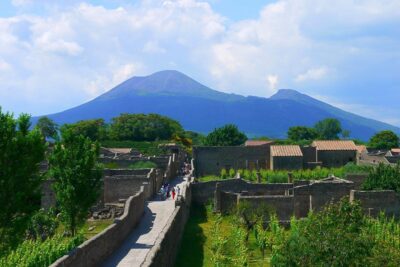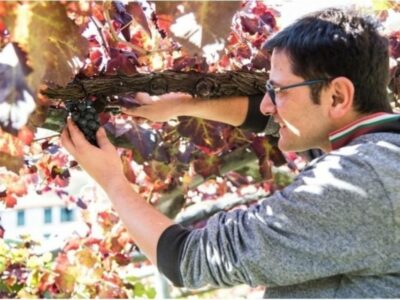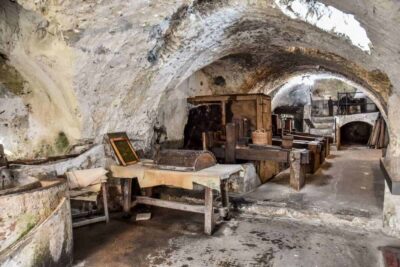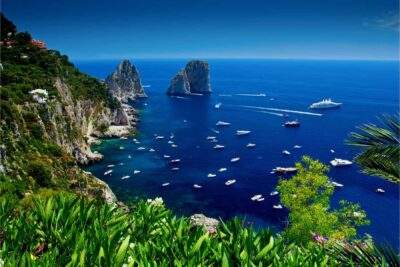Imagine the Amalfi Coast as a jewel: a small chain of precious gems, strung one after the other.
From Vietri sul Mare to Positano these colourful, sparkling stones follow one after the other. What makes this piece of jewellery unique and special is its irregularity: each stone, in fact, is different from the other and is characterised by something particular.
Thus, Vietri sul Mare is famous in Italy and the world over for its colourful ceramics, Cetara is the fishing village, famous for its colatura di alici, Maiori is identified as a delightful little town, full of life, Amalfi and Positano have that charm that mixes veracity and glamour: in short, each village that makes up the rich mosaic that is the Amalfi Coast has its own specific characteristic, almost its own identity, that distinguishes it from all the others.
In a way, we could say that the most aware ones can even notice a change of atmosphere between one village and another, as if it were a change of nuance, another shade of colour.
For example, Minori, which will be the protagonist of this article, is characterised by a more diffuse tourism during the year: it is rare to find, among its quiet streets, crowds of tourists, as happens, instead, at certain times of the year, in Amalfi and Positano.
Partly due to the characteristics of the town, which is smaller and offers fewer accommodation facilities, and partly due to its more ancient charm and quieter, more peaceful atmosphere, travellers arrive there more distributed throughout the year, intensifying between spring and autumn, but never reaching numbers that would cause chaos or excessive crowding.
We also talk about Minori in our comprehensive guide, where you will find all the information you need, both for visiting it and for staying overnight.
The benefit of this? You can wander pleasantly through the narrow streets of the village, enjoying the authentic coastal tranquillity. We consider it an ideal destination if you are travelling with children in tow. We also talk about it in this article, written with those travelling with the whole family in mind.
📣 Travellers who do not stay overnight here come to Minori to do four main things
✅ Taste the delicious desserts of master Sal De Riso, which we discuss in this dedicated article.
✅ Walk the Sentiero dei Limoni (Lemon Path), which we discuss in detail in this guide.
✅ Visiting the suggestive Roman Maritime Villa
✅ Visit the splendid Basilica dedicated to the Patron Saint.
In the following paragraphs, we will discuss precisely the last two attractions: two must-sees if you are passing through the town of Minori.
Table of Contents
📍 The Roman Maritime Villa of Minori
Some background on the Romans in Campania
We don’t know how well-versed you are in ancient history, but when in doubt, better to give you some background knowledge.
When visiting archaeological sites and historical monuments, one has a tendency to go there more out of some sort of sense of duty than to enjoy the fascination of the ancient walls and remains of our predecessors.
We find that knowing a few background facts helps a lot to fully enjoy the atmospheres one can get in this kind of experience.
You have to know that in ancient times the Romans used to own villas in the country: always lovers of the healthy life and aware of the value of the ‘rustic’ economy, which in previous centuries had formed the backbone of their civilisation, our ancestors, even when they became more urban and more accustomed to city activities, continued to own villas in the country.
We are, of course, talking about the wealthy aristocrats who, while living in the city, continued to own villas in areas far from the centre, administered by a villicus, who provided for the cultivation of the land.
At certain times of the year, they went there both to rest and to direct the agricultural work of the following season.
When, after 31 B.C., Octavian defeated Antony and Cleopatra, the much sought-after peace that was restored had the effect of changing certain aspects of Roman culture: there was a feeling that a new Golden Age was beginning again, and this connected the ancient Romans more closely with that need for ‘Otium’, which found its best ally in nature.
Thus, in the following decades, the increasingly widespread tendency of patricians was to build sumptuous Otium Villas in Campania, a place chosen for its temperate climate and for the presence of those places steeped in mythical tradition, which so tickled the pride and imagination of our beloved nobles, in need of rest and beauty.
Precisely for these reasons, Campania is still teeming with marvellous Roman villas: in addition to the one in Minori, those in Capri are also famous, and a few years ago the Roman Villa in Positano was finally opened to the public.
Just think that Cicero owned villas in Pompeii and Pozzuoli, Pompey and Caesar preferred Bacoli, Lucius Calpurnius Piso owned the famous villa dei Papiri in Herculaneum.
And these are just some of the Roman nobles who chose Campania as their favourite place to relax.
Needless to say, they did not miss the beauty of the Amalfi Coast.
And here we are, talking about Minori’s Roman Maritime Villa.
The Roman Maritime Villa of Minori
The Roman Maritime Villa in Minori is a relatively recent discovery: it came to light in 1932, following the collapse of a building, during some renovation work.
Although some work to unearth the finds had already begun in 1934, the rooms of the Roman Villa only emerged in 1954, following the disastrous flood of that year.
The Villa we visit today is not, in fact, complete: according to some studies, it stretched all the way to the sea, descending along the slope of the valley. From reconstructions, it seems to have extended over 2500 square metres, occupying almost the entire valley.
In short, the Roman patricians certainly did not experience the problems of the real estate speculative bubble that we experience today!
Of these ancient splendours, only the part built near the sea remains today.
The Roman Maritime Villa of Minori was built around the 1st century AD and remained in use, despite having different functions, until the 7th century AD.
The spaces of the Roman Villa
The Triclinium-Ninphaeum: the heart of the villa
At the centre of the villa stands the majestic triclinium-ninphaeum, the heart of the residence. This room, intended for banquets and social gatherings, was decorated with frescoes and mosaics depicting hunting scenes and marine deities, creating an enchanting and relaxing atmosphere. The presence of a basin and a small waterfall, fed by a complex hydraulic system, gave the room a fresh and evocative air.
Try this game with your imagination when you visit the rooms of the Roman Villa of Minori!
The reception rooms: elegance and refinement
Around the triclinium were the reception halls, rooms designed to welcome guests and emphasise the social status of the villa’s owner. Characterised by barrel or ribbed vaults, these rooms were decorated with stuccoes and frescoes depicting geometric motifs, mythological figures and landscapes. The music room, in particular, was a particularly impressive room, with its walls adorned with musical instruments and scenes of everyday life.
The thermal area: wellness and relaxation
Another area of great interest is the thermal sector, where the Romans could devote themselves to the well-being of body and soul. The thermal complex included the tepidarium (lukewarm bath) and the calidarium (hot bath), rooms heated by a sophisticated hypocaust system. The walls of the baths were decorated with mosaics depicting geometric motifs and mythological figures, creating a relaxing and regenerating atmosphere.
The antiquarium: a treasure trove of exhibits
Inside the antiquarium you can admire a rich collection of archaeological artefacts found during excavations at the villa and at other sites on the Amalfi Coast. Among the most important finds are ceramics, mosaics, sculptures and objects of daily use, which give a precise idea of the life of the ancient Romans.
The viridarium and gardens: an oasis of peace
The villa was surrounded by a large garden, the viridarium, where the owners and their guests could stroll and relax. The garden was decorated with ornamental plants, sculptures and water features, creating an oasis of peace and tranquillity.
When you can visit the Roman Maritime Villa in Minori
🔹It is closed on Mondays.
🔹Tuesday through Saturday from 9:00 am to 7:00 pm.
🔹 Sundays from 9:00 am to 1:30 pm.
🔹Admission is free.
📍 The Basilica of Santa Trofimena
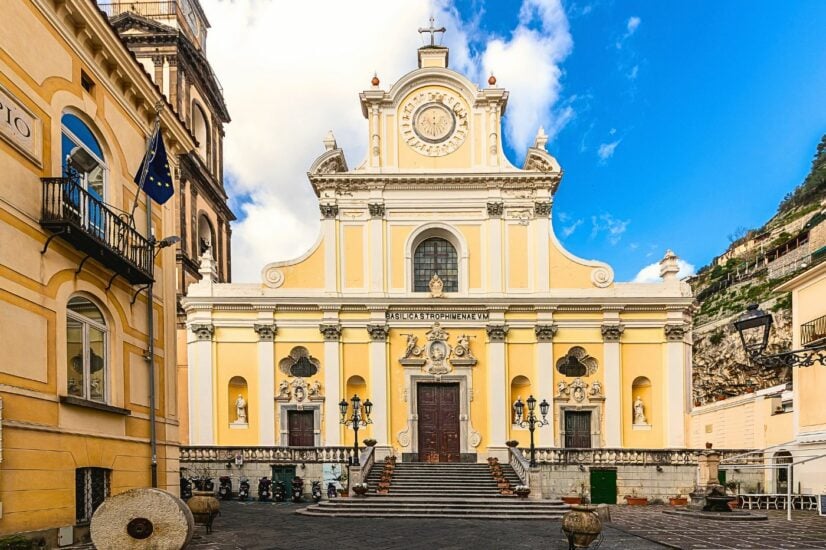
Another unmissable monunent, if you are passing through Minori, is undoubtedly the Basilica of Santa Trofimena, dedicated to the patron saint of the town.
It is, in fact, a masterpiece of 18th-century sacred architecture that enchants visitors and the faithful alike.
Its construction, following the demolition of the previous cathedral, resulted in a majestic and luminous building, characterised by simple and elegant lines. The interior, divided into three naves and decorated with stucco and polychrome marble, houses priceless works of art, including the altarpiece depicting the Crucifixion, attributed to Marco del Pino of Siena. An atmosphere of deep spirituality envelops the crypt, reached by two flights of stairs, where the relics of Saint Trofimena rest in a fine marble urn.
The statue of the Saint, placed in the apse, is a further focal point of popular devotion. The imposing bell tower, with its square plan and large windows, completes the image of this architectural jewel.
When you can enter the Basilica of Santa Trofimena
The Church is open daily from 9am to 12pm and from 5pm to 8pm.
📣 Some curiosities about the patron saint of Minori
The people of Minori are extraordinarily devoted to their patron saint. They celebrate her three times a year: on 5 and 27 November and on 13 July.
On 13 July, which celebrates the second deposition of the relics in 839, the festivities involve all the townspeople in a festive and solemn atmosphere, with a band concert, the procession of the Saint through the streets of the town, and the traditional final fireworks display.
A typical dish of the festivity is the ‘ndundero alla minorese: the ’nduderi are a type of fresh pasta, similar to gnocchi (we talk about them in detail in this article), which are traditionally served with tomato sauce and sausage, although the imagination of local chefs offers the most varied and tasty combinations.


